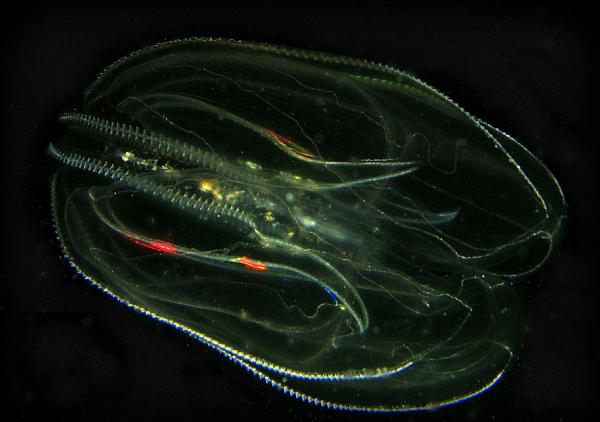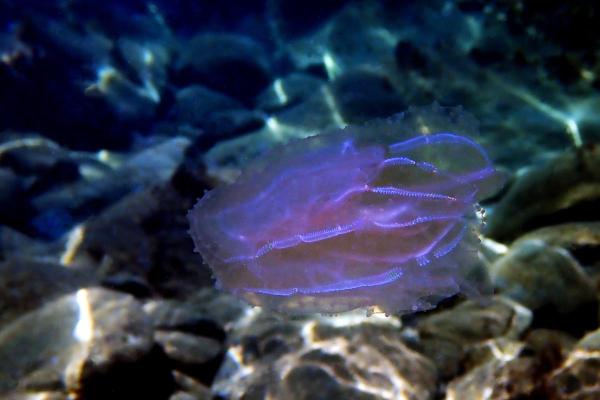
The story of comb jellies stretches back to the dawn of animal life itself, some 700 million years ago, when the first multicellular organisms were beginning to emerge from their single-celled ancestors. For decades, scientists believed they understood the base of the animal family tree, with simple sponges occupying the lowest branch. However, recent genetic and chromosomal evidence has challenged this view, suggesting that comb jellies might have diverged first from our common ancestor, making them perhaps the most ancient animal lineage still alive today.
In this article by thedailyECO, we explore whether the comb jelly is the earliest animal on Earth and uncover what these gelatinous swimmers reveal about the dawn of animal evolution.
What are comb jellies?
Comb jellies, or ctenophores, are marine invertebrates recognized for their gelatinous bodies and movement powered by rows of cilia, called "combs."
These creatures usually range in size from a few millimeters to about 10 centimeters (0.4 to 4 inches) long, although some species grow larger. Many comb jellies are bioluminescent, producing blue-green light, which may help attract prey or deter predators.
A defining feature of comb jellies is their use of colloblasts. These are specialized cells that release a sticky substance to capture prey such as zooplankton, small crustaceans, and fish larvae. Unlike jellyfish and other cnidarians, comb jellies do not have stinging cells and rely entirely on their colloblasts for feeding.
Comb jellies have a simple body structure made up of two main layers of cells with a jelly-like substance called mesoglea in between. This simple structure gives them a soft, jelly-like body.
There are around 100-150 known species of comb jellies, each with unique characteristics. Their comb rows often create an iridescent effect by refracting light, making them visually striking in the water.
Comb jellies are found in oceans worldwide, from surface waters to deep seas. While many species are harmless and integral to marine ecosystems, some, like Mnemiopsis leidyi, have become invasive in certain regions, affecting local biodiversity and food webs.
Did you know these iridescent hunters have neither brains nor hearts? Uncover more surprising facts about comb jellies in our other article.

What's Earth's oldest animal?
The question of which animal lineage appeared first on Earth has intrigued scientists and the public for decades. Recent research suggests that comb jellies (Ctenophora) may have been the earliest animals, emerging around 700 million years ago. However, this remains a topic of active debate.
Sponges were long considered the earliest animal lineage because of their simple body structure. Unlike all other animals, sponges lack muscles and nerves, and they use specialized cells called choanocytes to filter food from the water. These choanocytes look remarkably similar to choanoflagellates, single-celled organisms that are the closest known relatives of animals.
Despite this evidence, the idea remains contentious. Some studies, using alternative methods or datasets, continue to support the sponge-first hypothesis. One of the major challenges in resolving this debate is the scarcity of fossils from the early stages of animal evolution. Even if comb jellies are the earliest lineage, this does not make them the most primitive - early animals likely looked very different from their modern descendants.
Sponges, with their unique cellular organization and lack of true tissues, play a crucial role in the discussion of early animal evolution. Be sure to read our article on sea sponges.

Why are comb jellies considered the first animals?
Recent chromosomal research has provided compelling new insights into early animal evolution. By examining the arrangement of genes on chromosomes (synteny), scientists discovered that comb jellies share unique genetic patterns with their single-celled relatives - patterns that differ significantly from all other animals.
This research revealed two distinct evolutionary paths: one lineage retained the original chromosomal arrangement, evolving into modern comb jellies, while another underwent a significant reshuffling of its genes, eventually giving rise to sponges and all other animal groups.
Scientists found that in comb jellies and unicellular outgroups, 14 distinct groups of genes existed on separate chromosomes, while in sponges and other animals, these same genes were fused into seven chromosomal groups.
This chromosomal evidence suggests that comb jellies branched off as a "sister group" to all other animals, representing the earliest diverging animal lineage. These ancient evolutionary events have left lasting traces in the genomes of these organisms, detectable even after hundreds of millions of years, providing crucial insights into the origins of animal life.

How did comb jellies evolve?
Scientists believe comb jellies evolved from single-celled ancestors, though the exact details of this transition remain one of evolution's most intriguing puzzles. Recent genetic research (1) has revealed fascinating clues about these origins.
The closest known relatives to early comb jellies were likely single-celled organisms similar to modern choanoflagellates and filastereans. However, comb jellies evolved some remarkable innovations that set them apart.
They developed specialized cells for movement (using unique structures called ctenes, or "combs"), digestion, and even a simple nervous system. These features represent major evolutionary advances from their single-celled ancestors.
What makes comb jellies particularly interesting is that they may have developed these complex features independently from other animals. Their nervous system, for example, uses different neurotransmitters than those found in other animals, suggesting it evolved separately. This independent evolution of complex features makes comb jellies a fascinating case study in evolutionary biology.
While fossils from this early period are extremely rare, molecular evidence suggests this transition from single-celled organisms to early comb jellies occurred around 700 million years ago, during a period when Earth was experiencing significant environmental changes.
Did you know that sometimes different species arrive at the same solutions independently? Discover how in our article on parallel evolution.
If you want to read similar articles to Is the Comb Jelly the First Animal on Earth?, we recommend you visit our Wild animals category.
- Ryan, J. F., Pang, K., Schnitzler, C. E., Nguyen, A. D., Moreland, R. T., Simmons, D. K., Koch, B. J., Francis, W. R., Havlak, P., Smith, S. A., Putnam, N. H., Haddock, S. H. D., Dunn, C. W., Wolfsberg, T. G., Mullikin, J. C., & Martindale, M. Q. (2013). The genome of the ctenophore Mnemiopsis leidyi and its implications for cell type evolution. Nature, 499(7458), 154–158. https://doi.org/10.1038/nature12252
- Schultz, DT, Haddock, SHD, Bredeson, JV et al. Ancient gene linkages support ctenophores as sister to other animals. Nature 618, 110–117 (2023). https://doi.org/10.1038/s41586-023-05936-6
- National Marine Sanctuary Foundation. (2021). Sea Wonder: Comb Jelly. https://marinesanctuary.org/blog/sea-wonder-comb-jelly/
- Singh, S. (2023). New research hints that comb jelly may be Earth's oldest animal. CBS NEWS. https://www.cbsnews.com/news/earth-first-animal-comb-jelly-ctenophore-700-million-years-ago/
- MARINE BIOLOGICAL LABORATORY. (sf). Comb Jelly. MBL. https://www.mbl.edu/research/research-organisms/comb-jelly